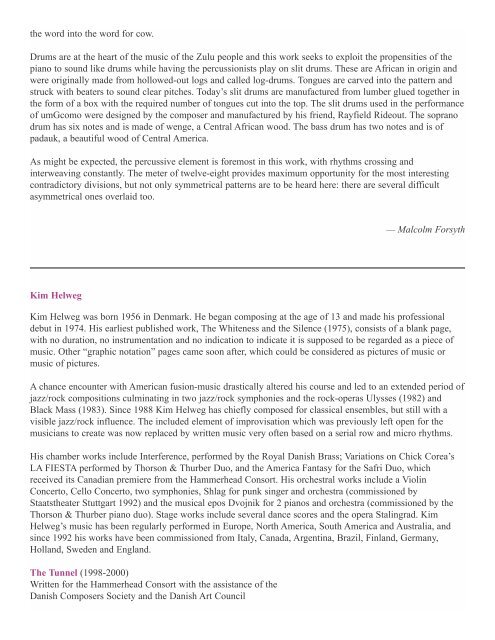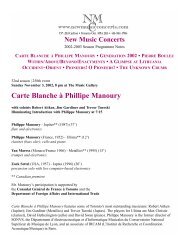2004-2005 Season The Hammerhead Consort - New Music Concerts
2004-2005 Season The Hammerhead Consort - New Music Concerts
2004-2005 Season The Hammerhead Consort - New Music Concerts
Create successful ePaper yourself
Turn your PDF publications into a flip-book with our unique Google optimized e-Paper software.
the word into the word for cow.<br />
Drums are at the heart of the music of the Zulu people and this work seeks to exploit the propensities of the<br />
piano to sound like drums while having the percussionists play on slit drums. <strong>The</strong>se are African in origin and<br />
were originally made from hollowed-out logs and called log-drums. Tongues are carved into the pattern and<br />
struck with beaters to sound clear pitches. Today’s slit drums are manufactured from lumber glued together in<br />
the form of a box with the required number of tongues cut into the top. <strong>The</strong> slit drums used in the performance<br />
of umGcomo were designed by the composer and manufactured by his friend, Rayfield Rideout. <strong>The</strong> soprano<br />
drum has six notes and is made of wenge, a Central African wood. <strong>The</strong> bass drum has two notes and is of<br />
padauk, a beautiful wood of Central America.<br />
As might be expected, the percussive element is foremost in this work, with rhythms crossing and<br />
interweaving constantly. <strong>The</strong> meter of twelve-eight provides maximum opportunity for the most interesting<br />
contradictory divisions, but not only symmetrical patterns are to be heard here: there are several difficult<br />
asymmetrical ones overlaid too.<br />
Kim Helweg<br />
— Malcolm Forsyth<br />
Kim Helweg was born 1956 in Denmark. He began composing at the age of 13 and made his professional<br />
debut in 1974. His earliest published work, <strong>The</strong> Whiteness and the Silence (1975), consists of a blank page,<br />
with no duration, no instrumentation and no indication to indicate it is supposed to be regarded as a piece of<br />
music. Other “graphic notation” pages came soon after, which could be considered as pictures of music or<br />
music of pictures.<br />
A chance encounter with American fusion-music drastically altered his course and led to an extended period of<br />
jazz/rock compositions culminating in two jazz/rock symphonies and the rock-operas Ulysses (1982) and<br />
Black Mass (1983). Since 1988 Kim Helweg has chiefly composed for classical ensembles, but still with a<br />
visible jazz/rock influence. <strong>The</strong> included element of improvisation which was previously left open for the<br />
musicians to create was now replaced by written music very often based on a serial row and micro rhythms.<br />
His chamber works include Interference, performed by the Royal Danish Brass; Variations on Chick Corea’s<br />
LA FIESTA performed by Thorson & Thurber Duo, and the America Fantasy for the Safri Duo, which<br />
received its Canadian premiere from the <strong>Hammerhead</strong> <strong>Consort</strong>. His orchestral works include a Violin<br />
Concerto, Cello Concerto, two symphonies, Shlag for punk singer and orchestra (commissioned by<br />
Staatstheater Stuttgart 1992) and the musical epos Dvojnik for 2 pianos and orchestra (commissioned by the<br />
Thorson & Thurber piano duo). Stage works include several dance scores and the opera Stalingrad. Kim<br />
Helweg’s music has been regularly performed in Europe, North America, South America and Australia, and<br />
since 1992 his works have been commissioned from Italy, Canada, Argentina, Brazil, Finland, Germany,<br />
Holland, Sweden and England.<br />
<strong>The</strong> Tunnel (1998-2000)<br />
Written for the <strong>Hammerhead</strong> <strong>Consort</strong> with the assistance of the<br />
Danish Composers Society and the Danish Art Council




